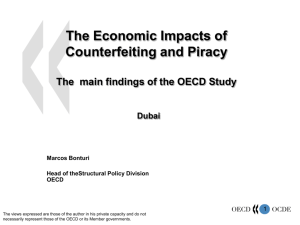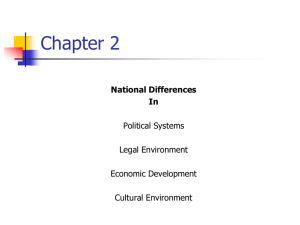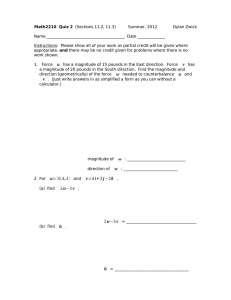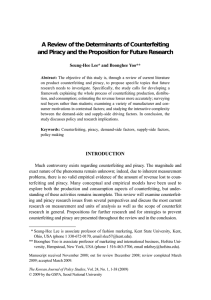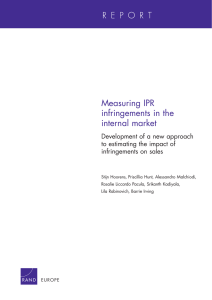OECD Research on Counterfeiting and Piracy; Economic and Policy Issues
advertisement
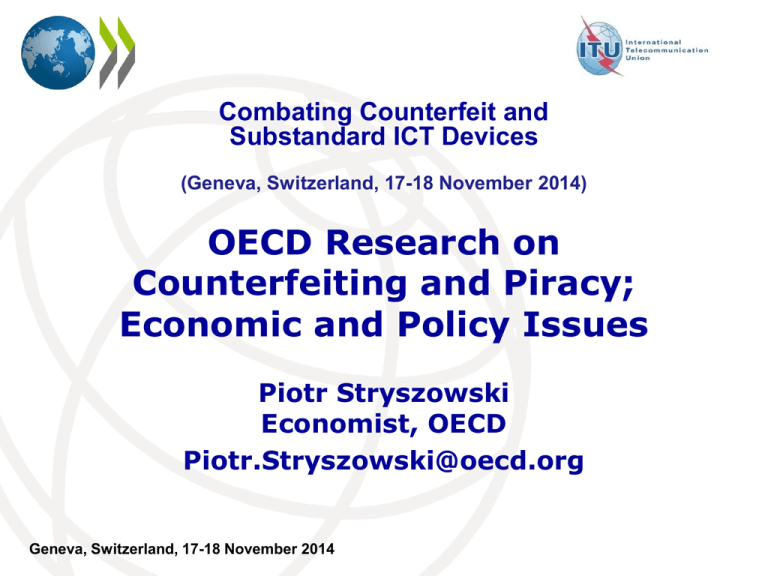
Combating Counterfeit and Substandard ICT Devices (Geneva, Switzerland, 17-18 November 2014) OECD Research on Counterfeiting and Piracy; Economic and Policy Issues Piotr Stryszowski Economist, OECD Piotr.Stryszowski@oecd.org Geneva, Switzerland, 17-18 November 2014 (PARIS, CDG AIRPORT) OECD studies on counterfeiting an piracy The initial project Counterfeit and pirated products (2008) Digital piracy (2009) 2009 Update of Phase 1 figure The upcoming project (2015-16) Scoping phase OECD studies on counterfeiting an piracy GOALS: To assess the magnitude of the problem To study the effects of counterfeiting and piracy To determine the relevant policy conclusions Measurement Measurement needs rigorous methodologies (what and how) • Magnitude – issue of measurement unit (volume, value, number of seizures) • Effects – on employment, profits, growth, etc. Data is hard to find • activities are illicit and clandestine • numerous industries affected • existing data is sparse, incomplete and inconsistent Measurement of counterfeiting and piracy has been a data driven exercise (not methodology based) Measurement What do we measure: Tangible products that infringe trademarks, copyrights, patents or design rights Data comes from: Surveys undertaken (customs authorities with the assistance of the World Customs Organisation, WCO) Tailored Methodology developed to assess the magnitude of the problem in international trade, principally using statistics on customs seizures Global scale All industries (HS categories) Counterfeiting and piracy Domestically produced and consumed counterfeit products Illicit Trade Trade in fakes Other illicit trade (e.g. drugs) Magnitude of the problem Customs data (WCO, One-off) “T.R.I.C.” indices Trade data Step 1 Absolute figure (UN comtrade) Time indices Step 2 Step 3 Magnitude of the problem (index) GTRIC-e (economies) Exporting economies Relative index: • • 10 – highest likelihood 0 – smallest likelihood 12.6% likelihood compared to the “top exporter” Magnitude of the problem (index) GTRIC-p (products) HS product categories Relative index: • • 10 – highest likelihood 0 – smallest likelihood Code 95 Toys, games & sports equipment; parts & accessories Magnitude of the problem (absolute number) Up to US$ 250 billion of international trade could have been in counterfeit or pirated products in 2007 The figure does not include – domestically produced and consumed products – non-tangible pirated digital products If added, the figure could be several hundred billion dollars higher Earlier figure of 5-7% of world trade lacks rigorous foundation and could not be confirmed or disproved Magnitude of the problem (time index) Trade in counterfeit and pirated goods grew steadily over the period 2000 – 2007 USD 300 bn ? USD 250 bn USD 200 bn USD 150 bn USD 100 bn USD 50 bn USD 0 bn 2000 2001 2002 2003 2004 2005 2006 2007 The upcoming project (2015-2016) Expert meeting (28.05.2014) Starting point: GTRIC Magnitude (new customs data) Economic and policy effects Regional case studies Industry case studies For the attention of policymakers Horizontal problem (finance; internal affairs; police; customs; health; labour …) There must be a clear C&P policy, supported by enforceable (and effectively enforced) legal and regulatory framework Improve co-ordination amongst domestic agencies Enhance co-operation with industry For the attention of policymakers International problem (active role of criminal networks) International co-operation (source countries, transit points) Awareness! Education of consumers/users is critical (not only end products, also B2B) Increase training/awareness amongst government officials Enforcement!!!! (PARIS, CDG AIRPORT) (PARIS, MONTMARTRE) for further information Piotr Stryszowski OECD 2, rue André-Pascal 75775 Paris CEDEX 16 France Email: Piotr.Stryszowski@oecd.org Phone: (+33) 1 4524 9130 Fax: (+33) 1 4430 6257
